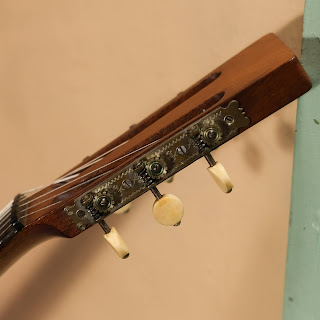1880s Haynes-made Benary Tilton-patent Parlor Guitar
Update 2020: I've updated the blog post information, photos, and added a new video clip.
While I've worked on actual Tilton-patent guitars, I haven't worked on one bearing the Benary branding in the soundhole or ones with this plain a level of trim. This was made by Haynes (of Bay State fame) for the Benary brand and other than the branding, it's essentially a plain-Jane version of the Tilton-patent guitars that the firm also made. This means it has the tailpiece setup and an internal spruce rod running the length of the body to give rigidity to the neck and endblocks. Differences from earlier variants include simpler trim, a thicker top with simple ladder bracing (our own upstairs has a form of x-bracing), and top grain oriented "as normal" rather than on a diagonal.
Still, don't get me wrong -- this is a tasty guitar! It has a punchy, direct voice that carries and sounds quite balanced compared to many period parlors which can sometimes be a bit murky or flat. With the current strings on it, it has a nice, "fingerpicked steely" sound to it. I'm guessing with normal-style classical strings (this is meant for gut/nylon, so classical-tension sets only, please) it would a bit warmer but also with a bit less sustain and jangle.
This has specs close to a Martin "size 1" with an 11 3/8" lower bout. It's a great little "couch potato" guitar and feels like an outsized baritone uke in the lap. The tuners are what make me think this is an 1880s guitar as opposed to an 1890s one. Usually Haynes products have serial numbers stamped in the headstock, but this guitar does not.
Repairs included: a neck reset, fret level/dress, two new rosewood bridges (one for 3/32" action height and one for 1/16"), and setup.
Setup notes: the owner has it strung with Thomastik KR116s which are a hybrid rope-core-steel classical set and it's playing beautifully with spot-on 3/32" action overall at the 12th fret.
Scale length: 24 1/2"
Nut width: 1 3/4"
String spacing at nut: 1 1/2"
String spacing at bridge: 2 3/16"
Body length: 18"
Lower bout width: 11 3/8"
Side depth at endpin: 3 5/8"
Top wood: solid spruce
Back & sides wood: solid mahogany
Bracing type: ladder
Fretboard: rosewood
Bridge: rosewood
Bridge: rosewood
Neck feel: medium hard-V shape, ~10" board radius
Neck wood: mahogany, ebony nut
Neck wood: mahogany, ebony nut
Condition notes: in the past this has had a refinish job and some older repairs. The pickguard is, clearly, not original. It also came-in with a "floating" bridge that'd been glued-down in a couple spot. The refinish work was nice, however, and doesn't hurt the appeal of the guitar. Its mahogany back/sides and spruce top glow in a nice, soft, satin that apes a period look.



















Comments
Tim Dillon
Monroe, MI
PS: Sorry, i realize this is a late comment.